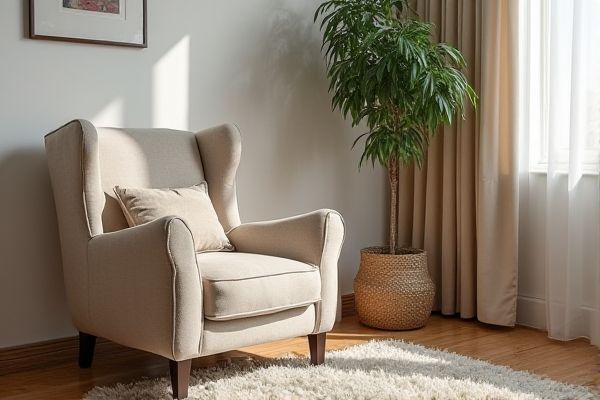
An armchair typically features padded arms and a cushioned seat designed for maximum comfort and relaxation, making it ideal for living rooms or reading nooks. Understanding the distinct styles and purposes of armchairs versus accent chairs can help you choose the perfect piece to complement Your home's decor--read on to explore their unique benefits and design tips.
Table of Comparison
| Feature | Armchair | Accent Chair |
|---|---|---|
| Purpose | Comfortable seating focused on support | Decorative seating enhancing room aesthetics |
| Design | Typically larger with padded arms and back | Varied styles, often visually striking or unique |
| Usage | Everyday lounging in living rooms or reading nooks | Occasional use to complement interior decor |
| Material | Soft fabrics, leather, cushions for comfort | Mixed materials emphasizing aesthetics (wood, metal, fabric) |
| Size | Generally larger and bulkier | Varies; can be compact and lightweight |
| Placement | Central in seating arrangements | Placed to accent or highlight a space |
Introduction: Armchair vs Accent Chair
Armchairs typically offer more padded comfort and larger dimensions, making them ideal for relaxation and long seating periods. Accent chairs prioritize style and design, often featuring unique shapes or bold fabrics to enhance room decor. Understanding the distinct functions of your armchair vs accent chair helps you choose the perfect seating solution for both comfort and aesthetic appeal.
Defining Armchairs and Accent Chairs
Armchairs are typically designed for comfort and support, featuring cushioned seats, backs, and armrests, making them ideal for relaxation and everyday use. Accent chairs prioritize style and visual appeal, often showcasing unique designs, bold colors, or patterns to complement and enhance interior decor. While both provide seating, armchairs focus on functionality, whereas accent chairs serve as decorative statement pieces within a room.
Key Design Differences
Armchairs typically feature fully upholstered seats with a high back and armrests designed for comfort and relaxation, making them ideal for living rooms or reading nooks. Accent chairs are primarily decorative, often showcasing unique patterns, bold colors, or distinctive shapes, serving as focal points to complement existing furniture. While armchairs emphasize ergonomic support, accent chairs prioritize aesthetic appeal and style versatility within a space.
Comfort and Functionality Comparison
Armchairs offer plush cushioning and ergonomic support designed for extended seating comfort, making them ideal for relaxation and reading. Accent chairs prioritize aesthetic appeal and versatile functionality, often featuring stylish designs that complement room decor while providing moderate comfort for occasional use. Both chair types enhance living spaces by combining comfort with functional seating options tailored to different user needs.
Materials and Upholstery Options
Armchairs commonly feature sturdy wooden or metal frames with thicker padding, offering upholstery options such as leather, velvet, or high-density foam for enhanced comfort. Accent chairs prioritize style with more diverse materials like rattan, acrylic, or sculpted wood, and often use bold fabrics, patterned textiles, or textured upholstery to create visual interest. The choice between armchair and accent chair materials significantly impacts durability, comfort, and aesthetic appeal in interior design.
Space Suitability and Room Placement
Armchairs are typically larger and offer ample seating space, making them ideal for living rooms or reading nooks where comfort is a priority. Accent chairs, being more compact and stylistically distinct, serve as decorative focal points suitable for smaller areas like bedrooms or entryways. Choosing between the two depends on room size and desired function, with armchairs enhancing coziness and accent chairs adding visual interest without overwhelming the space.
Aesthetics: Style and Visual Impact
Armchairs typically offer a classic, cozy design with plush cushioning that enhances comfort and warmth in your living space. Accent chairs stand out with bold patterns, unique shapes, or vibrant colors, serving as a focal point that adds personality and visual interest to any room. Choosing between them depends on whether you want to prioritize overall comfort or make a distinctive style statement.
Cost and Budget Considerations
Armchairs typically cost more due to their larger size and enhanced cushioning, making them a substantial investment for your living space. Accent chairs tend to be more budget-friendly, offering stylish, smaller seating options that fit easily within tight spaces. Your choice depends on balancing comfort preferences with available budget constraints.
Maintenance and Durability
Armchairs typically offer sturdier frames and higher-quality upholstery materials, making them more durable for frequent use. Accent chairs prioritize style and may feature delicate fabrics or intricate designs that require careful maintenance to prevent damage. Your choice should balance the need for long-lasting wear with the ease of cleaning and upkeep based on daily use.
Choosing the Right Chair for Your Home
Selecting the right chair for your home depends on comfort and design needs; armchairs offer deep cushioning and wide seating ideal for relaxation, while accent chairs provide stylish pops of color and pattern to enhance room aesthetics. Consider the chair's function--armchairs suit living rooms and reading nooks best, whereas accent chairs work well in entryways or as statement pieces. Material choices, size, and room layout also influence whether an armchair or accent chair complements your home decor perfectly.
 homyna.com
homyna.com